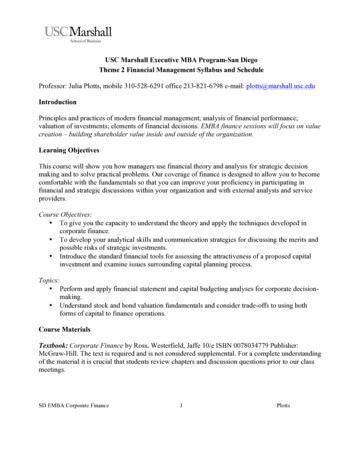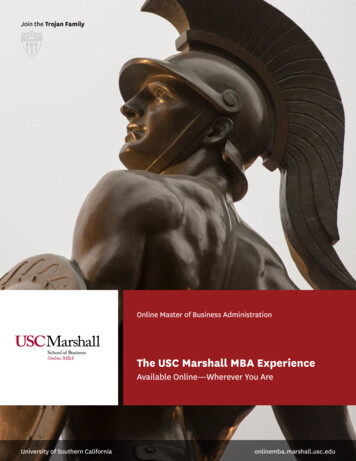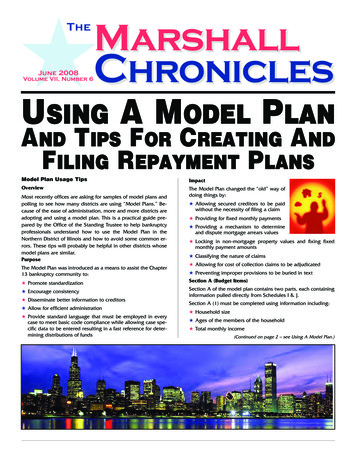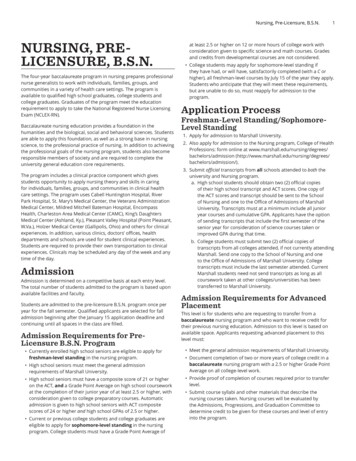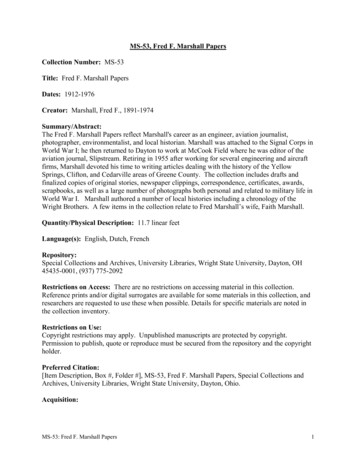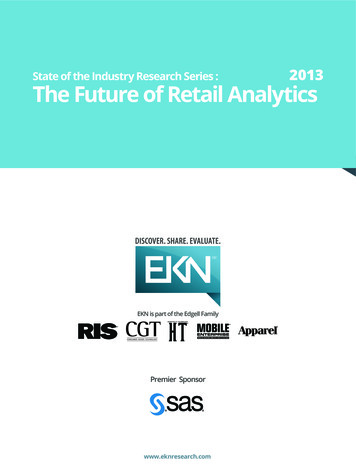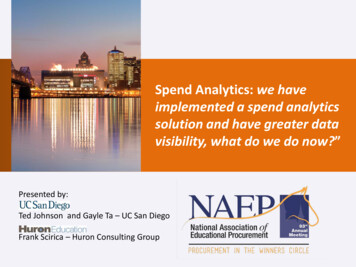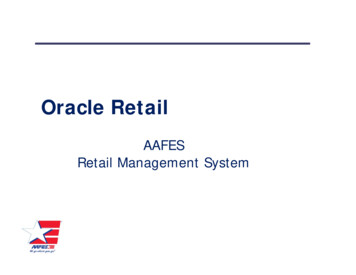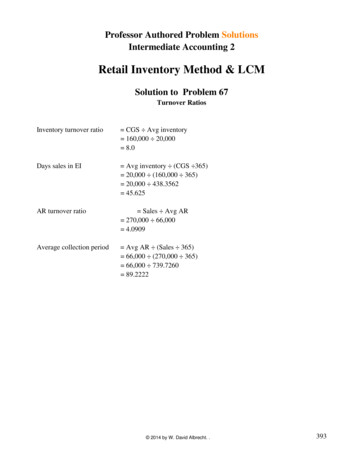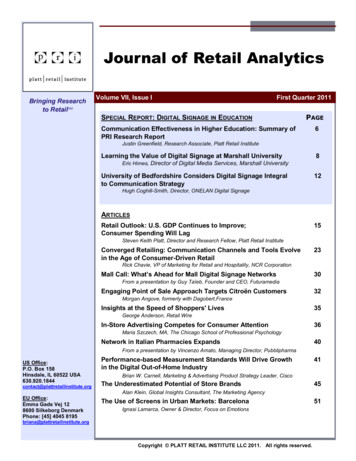
Transcription
Journal of Retail AnalyticsBringing Researchto Retail SMVolume VII, Issue IFirst Quarter 2011SPECIAL REPORT: DIGITAL SIGNAGE IN EDUCATIONPAGECommunication Effectiveness in Higher Education: Summary ofPRI Research Report6Justin Greenfield, Research Associate, Platt Retail InstituteLearning the Value of Digital Signage at Marshall University8Eric Himes, Director of Digital Media Services, Marshall UniversityUniversity of Bedfordshire Considers Digital Signage Integralto Communication Strategy12Hugh Coghill-Smith, Director, ONELAN Digital SignageARTICLESRetail Outlook: U.S. GDP Continues to Improve;Consumer Spending Will Lag15Steven Keith Platt, Director and Research Fellow, Platt Retail InstituteConverged Retailing: Communication Channels and Tools Evolvein the Age of Consumer-Driven Retail23Rick Chavie, VP of Marketing for Retail and Hospitality, NCR CorporationMall Call: What‟s Ahead for Mall Digital Signage Networks30From a presentation by Guy Taïeb, Founder and CEO, FuturamediaEngaging Point of Sale Approach Targets Citroën Customers32Morgan Angove, formerly with Dagobert,FranceInsights at the Speed of Shoppers' Lives35George Anderson, Retail WireIn-Store Advertising Competes for Consumer Attention36Maria Szczech, MA, The Chicago School of Professional PsychologyNetwork in Italian Pharmacies Expands40From a presentation by Vincenzo Amato, Managing Director, PubblipharmaUS Office:P.O. Box 158Hinsdale, IL 60522 formance-based Measurement Standards Will Drive Growthin the Digital Out-of-Home Industry41Brian W. Carnell, Marketing & Advertising Product Strategy Leader, CiscoThe Underestimated Potential of Store Brands45Alan Klein, Global Insights Consultant, The Marketing AgencyEU Office:Emma Gads Vej 128600 Silkeborg DenmarkPhone: [45] 4045 8195The Use of Screens in Urban Markets: BarcelonaIgnasi Lamarca, Owner & Director, Focus on Emotionsbriana@plattretailinstitute.orgCopyright PLATT RETAIL INSTITUTE LLC 2011. All rights reserved.51
SPECIAL REPORT: DIGITALSIGNAGE IN EDUCATIONLearning the Value of Digital Signageat Marshall Universityby Eric Himes, Director of Digital Media Services, Marshall UniversityMany university administrations offer significant resistance when it comes toapproving the installation of a digital signage network. Often, they look onlyat the bottom line and not the far-reaching benefits provided by a well-maintainedsignage network. However, the administration at Marshall University, located inHuntington, West Virginia, saw the value in a distributed network early and consistently worked toward that goal.Digital Signage is nothing new to Marshall University. In the early ‘90s, two departments, seeing the need to be able to get messages out to their students, usedCRT monitors and a character generator on the university‘s closed circuit cablesystem. In 1998, with the opening of the John Deaver Drinko Library, a budgetwas set up to purchase and maintain kiosks that would provide way finding andinformational services for students entering the new facility. The kiosks were managed by the university‘s IT department. There were attempts to develop the kiosks into a signage network.As the original kiosks agedpast their lifecycle, they werereplaced with 55-inch plasmascreens, then refreshed againwith 55-inch LCD monitors andpowered by Scala software.Still, the ―network‖ remainedtwo signs located in a singlebuilding.As with many universities, aheightened interest in effectivecommunication occurred afterFifty-five-inch LCD monitors are placed in areas where studentsthe tragedy at Virginia Tech inhave easy access.2007. An emergency notification system was proposed that utilized 47 signs located in key areas around themain campus. However, there was neither a sustainable model, nor the personnelor budget in place to sustain such a network. This required the university to rethink its approach to how it was going to create a network that would be an effective communications tool to reach the campus population.The following year was spent researching various products and visiting tradeshows to see what was available. In 2009, a growing campus community thatwanted digital signage became evident. Staff at the newly constructed recreationcenter wanted to purchase signs for their building, various colleges wanted signsin their lobby areas to promote their programs, and the campaign of the newlyelected student body president even included a promise to bring digital signage tothe student center. Many factions were forming and it became increasingly evident to central IT that an enterprise digital signage solution was needed.8
SPECIAL REPORT: DIGITALSIGNAGE IN EDUCATIONThere are many benefits that come from a campus-wide signage implementation,including:It provides an easy way to keep the brand and look of the university consistent.Instead of each department or college creating its own templates, Marshall decided that IT would work with the communications/marketing department to protect the brand. This consistent branding, from recruitment material to the websiteto the signage, helps potential students and campus visitors to recall marketingand recruiting material they have seen. As people are bombarded with messageseach day, they tend to remember quite a bit of what they saw but need a trigger torecall the information.It can reach out to faculty, staff, students and visitors with dynamic richmedia content.While newsletters and bulletin boards canonly deliver static information, digital signage can make use of many media typesto keep the information current and attention grabbing. Most digital signage systems are able to take advantage of dynamic content pulled from RSS feeds orother information systems. By linkingMarshall‘s Resource 25 Calendar forevent scheduling, the data that is enteredinto one system can be repurposed inreal-time by the signage network withoutneeding additional staff to extract thedata and schedule it on the network.Digital signage messages have the abilityto catch your attention and help you discover new information while websites andemails require you to log on to your computer or use your smart phone.Information is displayed on monitors for students,faculty, staff and visitors to read. Information includes campus updates, emergency messages andmuch more.It provides a means to send emergency messages.Numerous signage software packages have the ability to integrate with a university‘s emergency response plan. All signs or a specific group of signs can be controlled from a single point. Emergency messaging can often be triggered remotelyby email, web or text messaging. Warning systems such as fire alarms or securitysystems can trigger a prepared message and RSS feeds can be monitored forkeywords. For example, an RSS feed from the National Weather Service could bemonitored for a severe thunderstorm warning and when triggered, could display awarning on the signs. This integration can be a major justification for digital signage, however, a comprehensive emergency response plan is required. Oftentimes it is not the technology that is the hindrance to emergency messaging, butthe lack of a plan as to what will happen and who is responsible for taking action.It reduces printing and paper costs, as well as the waste created by disposing of out-of-date posters and other static signage.Many signs that are posted by students around campus can be unsightly and require personnel resources to remove the material. Static signage is often outdated and the digital signage provides an easy method to keep these communica9
SPECIAL REPORT: DIGITALSIGNAGE IN EDUCATIONtions clean and updated. It allows for a much faster dissemination of informationacross campus by allowing each sign to take advantage of campus-wide information, in addition to any department or college-specific announcements, without theexpense of printing.There is cost savings by having a central team manage the network maintenance with distributed content creation.This model introduces cost savings on many fronts. First, each department doesnot have the overhead of maintaining different software and the annual maintenance cost associated with it. With an enterprise installation, the overhead can bedistributed resulting in a substantially lower per unit investment. Also with a central team, training and support of the network is part of the team‘s job responsibilities. This team approach eliminates the knowledge of a system being lost whenthe employee who installed the system leaves the organization.One of the main challenges was to convince the various groups of the benefit of acampus-wide network over a smaller, building-specific implementation. Many ofthe departments did not see how a sign across campus could benefit what theywere trying to do with signage in their buildings. In the fall of 2009, Marshall hadthe opportunity to participate in a free pilot with Blackboard, Inc. In the pilot,Blackboard was testing a hosted ad-supported network model. They worked withthe university to identify 11 high traffic locations where as many students as possible would be able to see the signs. These locations included the recreation center and the student center, both of which were already investigating signage solutions for their spaces. During the pilot, a maximum playlist length of 10 minuteswas used. Half of the playlist time would be used by Blackboard to run advertisingand the other half would be used by the University to run its content. Each department was given permission to update the signs in their areas and central ITworked with communications/marketing to schedule campus-wide information tothe network. This distributed content model helped to keep the signage contentcurrent without the addition of extra staff to maintain the network. It was quicklyrealized by the pilot group on campus that they were able to reach a muchbroader audience because of a sign located outside their domain advertising theirevent.As part of the pilot agreement, Marshall allowed Arbitron to conduct a survey thatwould allow both Blackboard and the university to determine the effectiveness ofthe signage network. The results of the survey proved that signage efforts at theuniversity were successful. Not only did 96.2 percent of the respondents noticethe sign, but also 66.4 percent were able to recall one of the ads.TOTAL # of respRowTOTALNoticedthescreenWatchedscreen(most orsome ofthe time)23122215321866.4%94.4%100.0% 96.2%%Arbitron survey. Base: Marshall Students Only10OpporDidRecallRecallRecalltunity tonotany ad Butter- Suzukisee for noticefinger adad10 screenmin.91533.8% 66.4%6126.3%57RecallTMobilead9324.5% 40.4%
SPECIAL REPORT: DIGITALSIGNAGE IN EDUCATIONBlackboard ended the pilot in December of 2009; due to a poor economy, theyhad decided not to pursue the higher education market for their model. At thatpoint, the momentum had been built and it was decided to move quickly and setup another pilot to start in January after winter break. Students knew to watch thesigns and the content providers knew how effective the signage network was forthem. The university has since purchased a campus-wide license from FourWinds Interactive and is experiencing an increased interest in the signage network. The signage will be used extensively during freshman orientation includinga possible digital scavenger hunt and interaction with Twitter to answer questionsand get feedback while waiting in line.Currently there are 10 signs installed across campus from academic areas to recreation centers. Nine additional signs, four that will be touch screen, will be deployed during the summer of 2010 in administrative buildings and new studentareas. Future plans include: expanding the network to run as the screen saver oncomputers in IT-controlled labs; adding signs at remote campuses; and, buildingout the way-finding aspects of the network.Eric Himes is the Directorof Digital Media Servicesat Marshall University inHuntington, WV.11
Rick Chavie, VP of Marketing for Retail and Hospitality, NCR Corporation Mall Call: What‟s Ahead for Mall Digital Signage Networks 30 From a presentation by Guy Taïeb, Founder and CEO, Futuramedia Eng
